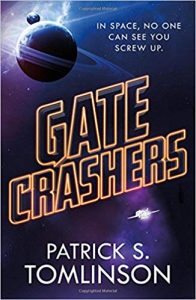 Review by Ernest Lilley
Review by Ernest Lilley
Originally published on SFRevu 5/1/21019:
Gate Crashers by Patrick S. Tomlinson
Tor Books 06/26/2018
400 years from now, mankind has reached out into interstellar space, established a few colonies, and has harnessed both fusion and gravity. But when the starship Magellan, ‘Maggie’ to her captain and friends, crosses an imaginary line in space 30 light years from home, only to find an alien artifact floating in space, humanity is about to enter the big time.
Gate Crashers is the first book in Patrick S. Tomlinson’s Breach series, which is billed as a comedy/space opera, but I think that’s off the mark. Yes, it has a fair number of wise-cracking crew members aboard the Magellan, and yes they get themselves in (and out of ) some absurd situations, but the plot is pure first contact/space opera, the sci-fi elements are well thought out, and the characters make an engaging ensemble. The humor skews a bit more towards MASH than Orville, of which, the author told us in our interview, he’s an unabashed fan and would love to write an episode.
The opening reminds me a bit of classic SF short story, The Warriors (1966) in which a ship from Earth has an eye-opening encounter a Kzin warship. The Magellan hasn’t encountered a warship, at least not yet, but it’s crossed a line that can’t be uncrossed, and broken a fence we didn’t even know existed.
The big question: is the fence supposed to keep us in, or others out?
The answer, of course, is a bit of both. Not so much a “Danger Human (check the links below for Gordon R. Dickson’s classic short story)” warning as “Leave the barbarians alone until they develop civilization and spaceflight”, and now we’ve managed at least one of the two.
In Niven’s story, the news got sent home by communications laser, which turns out not to be something you want to be in front of when it goes off, but here we’ve got Quantum Entanglement Radio (QER) which will be familiar to readers of Ursula LeGuin as an ansible, so even if it would take decades for the Magellan to take the artifact home, they can share information back and forth in ‘real’ time.
While the Magellan is wending its way home, the folks in charge of galactic fence mending are waking up, along with a few that think there’s an opening for a bit of conquest. Back on Earth, the best and brightest are working to unlock the secrets of the artifact, which has obligingly opened up to reveal its secrets. Or call for an alien repair tech. Whichever.
The result is that Maggie is at the center of two forces rushing together. An alien invasion on the one hand and an over-eager captain flying a hastily built Terran warship running on barely understood alien tech, testosterone, and an ego that would make James Tiberius Kirk blush. What could go wrong?
For the reader, nothing. It’s a setup full of classic riffs and references, the writing is good and the humor, as Mary Poppins never said, helps the medicine go down. It’s Space Opera alright, but it’s Light Space Opera (cue the Gilbert and Sullivan).
The cast makes the whole thing work. Allison, the captain of an exploratory vessel trying to mediate between aliens and the overblown ego of Max, the hero of Earth’s wars at home and determined to make his mark on the galaxy next. Two quirky engineers, one with a southern drawl and a starship to keep running, the other fresh out of college and saddled with coming up with Terran tech based on the artifact’s innards. Harris, the Marine who got promoted for being in the wrong place at the wrong time and is now in charge of Earth’s first platoon of space marines. And not to forget Maggie herself, a starship with a sense of duty and some understandable existential anxiety. And of course, the aliens, but we’ll let you meet them on your own.
Each chapter has a bit of a short story feel to it. Not that they’re disconnected, but Patrick doesn’t try to hook the reader into the next chapter with a cliffhanger, at least for the most part. Not that he has any problem pulling you along with the plot, but as far as I know he hasn’t written any short stories, and I suspect he’d be pretty good at it.
All in all, Gate Crashers is a good read on several levels. The writing is good, the characters are worth getting to know, the science fiction bits are well thought out, and it’s funny enough to be fun without being painful. Nice job.
Links / References
-
- Publisher’s Page: Gate Crashers by Patrick S. Tomlinson
- The Warriors</> (If, February 1966), Larry Niven
- DANGER—HUMAN (1957), Gordon R. Dickson
- Goodreads: Gate Crashers by Patrick S. Tomlinson